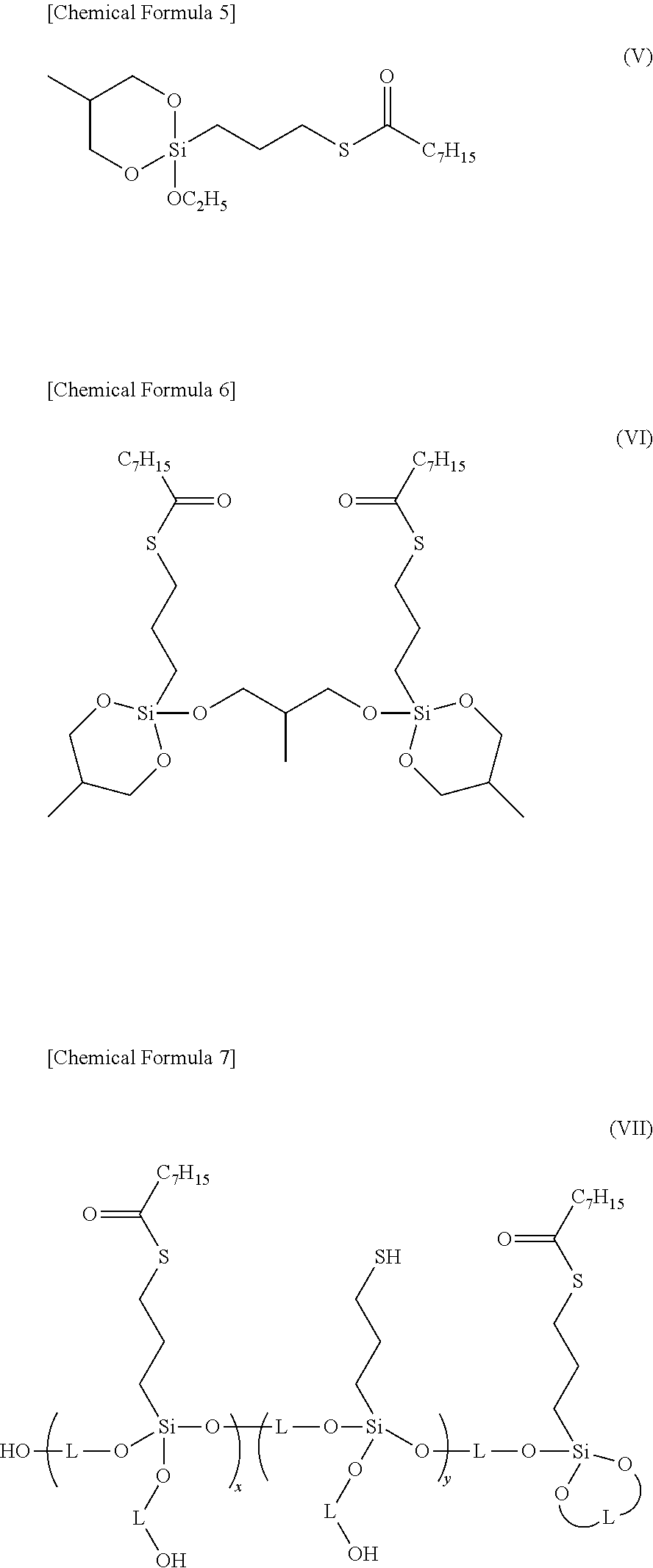Method for manufacturing rubber composition
- Summary
- Abstract
- Description
- Claims
- Application Information
AI Technical Summary
Benefits of technology
Problems solved by technology
Method used
Image
Examples
production example 1
Production of Silane Coupling Agent Represented by Average Compositional Formula (CH3CH2O)3Si—(CH2)3—S—(CH2)6—S2.5—(CH2)6—S—(CH2)3—Si(OCH2CH3)3:
[0087]119 g (0.5 mol) of 3-mercaptopropyltriethoxysilane was put into a 2-liter separable flask equipped with a nitrogen-introducing duct, a thermometer, a Dimroth condenser and a dropping funnel, and with stirring, 151.2 g (0.45 mol) of an ethanol solution of sodium ethoxide having an effective ingredient concentration of 20% by mass was added thereto. Subsequently, this was heated up to 80° C. and stirred for 3 hours. Afterwards, this was cooled and transferred into a dropping funnel.
[0088]Next, 69.75 g (0.45 mol) of 1,6-dichlorohexane was put into the same separable flask as above, heated up to 80° C., and the reaction product of 3-mercaptopropyltriethoxysilane and sodium ethoxide was slowly and dropwise added thereto. After the addition, this was stirred for 5 hours at 80° C. Subsequently, this was cooled, and salt was separated from the...
examples 20 to 26
, and Comparative Examples 10 to 16
[0095]According to the compositional formulation and the kneading method shown in Table 4, the rubber component, silica and the silane coupling agent were kneaded in the first stage (X) of kneading while the highest temperature of the rubber composition was kept controlled as in Table 4, then in the second stage (Y) of kneading, 1,3-diphenylguanidine was added and kneaded while the highest temperature of the rubber composition was kept controlled as in Table 4, and the vulcanizing agent and others were added and kneaded in the final stage (Z) of kneading thereby preparing the rubber compositions of Examples 20 to 26. On the other hand, as in Table 4, the stage (Y) was omitted in preparing the rubber compositions of Comparative Examples 10 to 16. In each stage of kneading, used was a Banbury mixer. The obtained 14 rubber compositions were evaluated in point of the low-heat-generation property (tanδ index) thereof according to the above-mentioned met...
examples 27 to 34
, and Comparative Examples 17 to 21
[0096]According to the compositional formulation and the kneading method shown in Table 5, the rubber component, silica and the silane coupling agent were kneaded in the first stage (X) of kneading while the highest temperature of the rubber composition was kept controlled as in Table 5, then in the second stage (Y) of kneading, 1,3-diphenylguanidine was added and kneaded while the highest temperature of the rubber composition was kept controlled as in Table 5, and the vulcanizing agent and others were added and kneaded in the final stage (Z) of kneading thereby preparing the rubber compositions of Examples 27 to 34. On the other hand, as in Table 5, the stage (Y) was omitted in preparing the rubber compositions of Comparative Examples 17 to 21. In each stage of kneading, used was a Banbury mixer. The obtained 13 rubber compositions were evaluated in point of the low-heat-generation property (tanδ index) thereof according to the above-mentioned met...
PUM
| Property | Measurement | Unit |
|---|---|---|
| Temperature | aaaaa | aaaaa |
| Temperature | aaaaa | aaaaa |
| Length | aaaaa | aaaaa |
Abstract
Description
Claims
Application Information
 Login to View More
Login to View More - R&D
- Intellectual Property
- Life Sciences
- Materials
- Tech Scout
- Unparalleled Data Quality
- Higher Quality Content
- 60% Fewer Hallucinations
Browse by: Latest US Patents, China's latest patents, Technical Efficacy Thesaurus, Application Domain, Technology Topic, Popular Technical Reports.
© 2025 PatSnap. All rights reserved.Legal|Privacy policy|Modern Slavery Act Transparency Statement|Sitemap|About US| Contact US: help@patsnap.com



